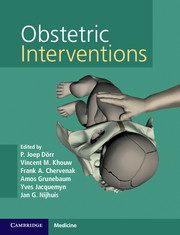Book contents
- Obstetric Interventions
- Obstetric Interventions
- Copyright page
- Contents
- Animations
- Contributors
- Preface
- Classification of Evidence Levels
- Section 1 Anatomy
- Section 2 Normal Labor and Delivery
- Section 3 Pathology of Labor and Labor and Delivery
- Chapter 3 Compound Presentation and Umbilical Cord Prolapse
- Chapter 4 Delivery of Twins
- Chapter 5 External Cephalic Version
- Chapter 6 Vaginal Breech Delivery
- Chapter 7 Operative Vaginal Delivery (Vacuum and Forceps Extraction)
- Chapter 8 Shoulder Dystocia
- Chapter 9 Retained Placenta
- Chapter 10 Placenta Accreta, Increta, and Percreta
- Chapter 11 Inversion of the Uterus
- Chapter 12 Technique for Cesarean Delivery
- Chapter 13 Sphincter Injury
- Section 4 Ethics of Obstetrical Interventions
- Index
- References
Chapter 7 - Operative Vaginal Delivery (Vacuum and Forceps Extraction)
from Section 3 - Pathology of Labor and Labor and Delivery
Published online by Cambridge University Press: 19 May 2017
- Obstetric Interventions
- Obstetric Interventions
- Copyright page
- Contents
- Animations
- Contributors
- Preface
- Classification of Evidence Levels
- Section 1 Anatomy
- Section 2 Normal Labor and Delivery
- Section 3 Pathology of Labor and Labor and Delivery
- Chapter 3 Compound Presentation and Umbilical Cord Prolapse
- Chapter 4 Delivery of Twins
- Chapter 5 External Cephalic Version
- Chapter 6 Vaginal Breech Delivery
- Chapter 7 Operative Vaginal Delivery (Vacuum and Forceps Extraction)
- Chapter 8 Shoulder Dystocia
- Chapter 9 Retained Placenta
- Chapter 10 Placenta Accreta, Increta, and Percreta
- Chapter 11 Inversion of the Uterus
- Chapter 12 Technique for Cesarean Delivery
- Chapter 13 Sphincter Injury
- Section 4 Ethics of Obstetrical Interventions
- Index
- References
- Type
- Chapter
- Information
- Obstetric Interventions , pp. 137 - 157Publisher: Cambridge University PressPrint publication year: 2017

